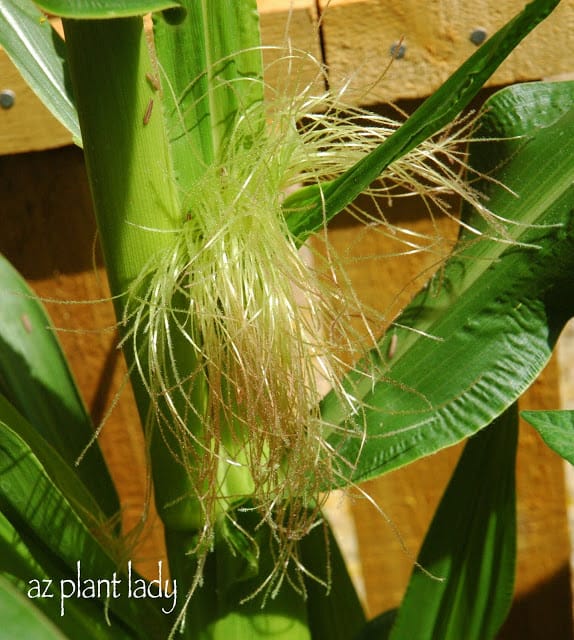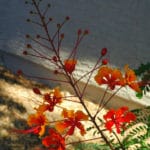Ears of Silk in the Vegetable Garden
Ripening Corn in My Vegetable Garden
In my vegetable garden, I’ve been closely monitoring the growth of our corn stalks and corn ripening stages; it’s been a fascinating journey.
Each day, these corn stalks grow noticeably by inches, and recently, we’ve observed a significant development – the emergence of the tassel, the male part of the corn plant.
Ripening Stages of My Garden Corn

Corn Ripening Stages
Did you know that corn is actually an edible herb that comes from the same family as grass?
–Noelle Johnson

Corn Ripening Stages
As we marveled at the tassels, full of yellow pollen, we couldn’t help but notice another intriguing phenomenon occurring on the sides of the corn stalks – the formation of corn silk. Each silk strand leads to a single ovary, and when fertilized, it will ultimately become a single kernel of corn.

After Pollen Comes Corn Silk
Corn silk has started to form. Each silk leads to a single ovary and when fertilized will turn in a single kernel of corn.
Now, when it comes to growing corn, it’s important to plant it in rows of at least three to ensure proper pollination. My vegetable garden only has two rows. To compensate for this, my kids and I decided to assist with the pollination process by gently shaking the cornstalks daily. This action creates a delicate cloud of yellow pollen that falls onto the silk.

After Fertilization Comes Corn Growth
Once the corn has been fertilized, the silk turns brown within 30 minutes indicating that it has been successfully pollinated. If you look closely at the picture above, you can see the pollen sticking to the silk. Below is a complete list of the 9 corn ripening stages you might see when growing corn.
The 9 Corn Ripening Stages
A fascinating and critical part of the corn growth cycle are the corn ripening stages. Understanding these stages can help farmers and gardeners alike determine the best time for harvesting corn. Here are the key stages of corn ripening:
1. Vegetative Growth:
This is the initial stage of corn development, where the plant focuses on building a strong root system and growing tall stalks and leaves. During this phase, the plant is primarily concerned with capturing sunlight and nutrients to support future growth.
2. Tassel Formation:
As the corn plant matures, it begins to develop the tassel, which is the male part of the plant. The tassel consists of long, slender structures that release pollen into the air. This pollen is essential for fertilizing the female parts of the plant.
3. Silk Emergence:
Concurrently with tassel development, the corn plant also produces silk, which is the female part of the plant. Each silk strand corresponds to a potential kernel of corn. The silks emerge from the ear (the part of the corn plant where the kernels will develop) and extend outward.
4. Pollination:
Pollination is a critical stage in corn ripening. Wind plays a crucial role in this process. Pollen from the tassels is carried by the wind to the silks, where fertilization takes place. Each silk strand must be pollinated for a kernel to develop. Proper pollination is essential for a good corn yield.
5. Kernel Formation:
After successful pollination, the fertilized silks start to develop into kernels. Each kernel corresponds to a single strand of silk. The kernels begin to swell and fill with starch, nutrients, and moisture.
6. Milk Stage:
At this stage, the developing kernels are filled with a milky fluid that contains sugars, proteins, and other nutrients. The kernels are still soft and not yet fully mature. This is a common stage for sweet corn harvest.
7. Dough Stage:
As the corn continues to ripen, the milky fluid in the kernels starts to become more solid, and the kernels become dough-like in texture. The corn is no longer suitable for sweet corn consumption but is ideal for certain types of corn products like cornmeal or hominy.
8. Dent Stage:
The kernels in this stage develop a dent at the top, giving the stage its name. The kernels have lost most of their moisture content and are considered mature. This stage is important for field corn varieties used for livestock feed and processing into various corn products.
9. Physiological Maturity:
At this final stage, the corn plant has reached its maximum dry weight. The kernels have hardened and have a low moisture content, making them suitable for harvesting. This stage is crucial for corn grown for grain production.

Multiple Ears of Corn on a Single Stalk
Surprisingly, some corn stalks produce not just one, but two ears of corn. While a typical corn stalk yields at least one ear, many varieties can produce two. Interestingly, the second ear forms after the first and is always smaller in size.
I bet you didn’t expect all of this corn trivia when you started to read this post, did you? Well, I love learning new things and vegetable gardening is somewhat new to me and I find so much of what I have learned fascinating.
I hope you enjoyed this exploration of corn ripening stages in my garden. Wishing you all a wonderful day!
Container Corn is “For The Birds”

 Noelle Johnson, aka, 'AZ Plant Lady' is a author, horticulturist, and landscape consultant who helps people learn how to create, grow, and maintain beautiful desert gardens that thrive in a hot, dry climate. She does this through her consulting services, her online class Desert Gardening 101, and her monthly membership club, Through the Garden Gate. As she likes to tell desert-dwellers, "Gardening in the desert isn't hard, but it is different."
Noelle Johnson, aka, 'AZ Plant Lady' is a author, horticulturist, and landscape consultant who helps people learn how to create, grow, and maintain beautiful desert gardens that thrive in a hot, dry climate. She does this through her consulting services, her online class Desert Gardening 101, and her monthly membership club, Through the Garden Gate. As she likes to tell desert-dwellers, "Gardening in the desert isn't hard, but it is different."









Very informational post! The part you and kids helped corns got pollinated is very interesting. I will never know that if I did not read your post!
We're not growing corn this year, but hopefully next year once the construction in the gardens is finished. I didn't realize that the silks turn brown quite that fast, although I have done the corn-shimmy-shake in the garden before to help the pollination process along. I look forward to seeing how your ears turn out!
Great corn-growing information! And beautiful photos. I bet you and your family are excited to know that corn is coming. Wish I had room for corn rows.
Very interesting-when we were children back home my parents had a a little farm and they grew grain and hay only to feed the cows. I´m a little bit curios about what you use corn mainly for. Nice pictures!
When I was researching ornamental grasses for some presentations I gave this year, I discovered that corn was a "warm season" grass. Which means it grows most actively when air temps are 80-95F. That means my state will never be the corn producting capital of the U.S. We rarely get a day over 75F in the summer. How sad for me…I love corn!
Christine in Alaska, corn-less
Beautiful post, and a great title! I love corn and the plants are so pretty, I wonder if it would be possible to grow them in containers?…
Great post about growing corn. I did not know that it was a member of the grass family. I bet you're looking forward to harvesting it, nothing is better than homegrown.
Nice pics and post. Pat and I aren't planting our garden till this weekend. jim
Even if i already know the science of pollination and fertilization, it is nice to read them in layman's terms. I am amused too! Your corn is so healthy and very well fed. I wish you also include a photo of all the corn plants, a wide angle of the garden. thanks Noelle. How do you use the corn, will you just boil them?
Wow, nice to see what comes of of the veg garden.
Wow. There were lots of things that I didn't know about corn in that post! But I'm very glad for the information as I am hoping to give growing corn a try again later this year – thanks Noelle!
I never knew any of that Noelle till I saw it here for myself – really interesting indeed.